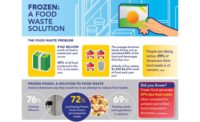How strategic alliances help refrigerated & frozen food brands grab consumer attention
The landscape of the food industry and how brands and consumers interact has changed drastically.

The landscape of the food industry and how brands and consumers interact has changed drastically. Consider how shoppers are making decisions. Who do they trust? Which marketing campaigns deliver maximum engagement from a distracted generation of shoppers?
Nearly 72% of consumers say they now only engage with marketing messages that are personalized and tailored to their interests, according to a report from SmarterHQ, Indianapolis, Ind. This desire for personalization is key for food brands determining how to move forward in capturing the attention of their shoppers. They want to know that the brands they are supporting in the checkout lane understand their wants and needs.
America’s savvy brands began targeting Millennials back in 2012. That would have put the upper Millennial at the ripe age of 15. Today, the Millennial consumers range from 23-38 years of age. Major lifestyle changes happen within those ages. At 16, female Millennials were preoccupied with lifestyle brands that supported their personal aspirational needs. Today, they have families of their own and focus on filling their family’s meal and snack appetites.
That lifestyle change also means today’s Millennial shopper is considering labels more. The Millennial shopper is buying for varying appetites and brand preferences. Mostly, however, it means they’re level of trust has changed. They trust their friends, family and co-workers more than ever.
The moral of the story—if you’re targeting Millennials the same way you were when your brand first started focusing on them, you may be speaking to an audience that has lost interest. This is where strategic alliances and partnerships can play a critical role within the food industry—when well-orchestrated, co-branded alliances can propel organic word of mouth and do an excellent job of promoting trial.
Here are three areas in which co-marketed efforts can help solve the mystery of trust and personalization:
- Target consumers where they shop.
By partnering with like-minded brands in a co-marketed capacity, whether on social media or in-store, each brand has the unique opportunity to make a larger impact market-by-market and regionally.
Where there is a need to encourage sales, smart brand alliances can intrigue shoppers enough to get them off of their couches and into the grocery store and back again once their pantry shelves need replenished. Brands that play in different spaces within the industry, but share similar values or attributes are in a position to play off of one another, encouraging their already-loyal consumers to expand their culinary horizons.
A lack of trust between shoppers and brands has driven both parties to change the way they interact with the each other – shoppers with increasing distrust and brands with a greater push for transparency. If the partnership is finely tuned, consumers feel well understood and well cared for by the brands that now share the responsibility of serving their food needs.
- Target consumers via content-driven strategies.
Millennial consumers have grown up in an age where content is the norm. Remembering shoppers have a base standard for exceptional content can help keep your perspective aligned with theirs.
With insatiable appetites for content, brand partnerships can fill the gap where content might lag or conversation might tend to fall on deaf ears. Visually engaging photography (whether stunning or raw and real) and captivating copy that says something of value is more likely to capture their interest. As you navigate the co-marketing waters, consider the engaging content you can promote and use it to capitalize on messages that are most critical for both brands to share.
- Enlist campaigns and experiential opportunities that break through the clutter.
Instinctively, food brand marketers strive to engage their shoppers where they’re at. At the point where a brand’s trajectory intersects with a consumer’s life, there is a prime opportunity to make a lasting impact.
According to research reported by Eventbrite, San Francisco, Millennials make up one-third of the U.S. population. This group, falling between the ages of 23-38, make up a huge percentage of event attendee bases. In fact, 75% of Millennials say they value experiences over things. Better yet, they are consistently putting their money where their mouths are. Nine out of 10 Millennials have attended at least one live event within the past 12 months – significantly up from three years ago (82%).
For this reason, experiential opportunities at which brands can participate, join the energy of the event and spend meaningful time with consumers are a prime strategy for those hoping to build a love brand.
In the age of distraction, how can refrigerated and frozen food brands grab consumer attention with content that amounts to more than click-bait? Quality content that serves both a real need and solves a real problem is how leading brands continuously stay top-of-mind for shoppers. In turn, they are rewarded with loyalty, which is oftentimes the scarcest of commodities today.
In the end, consumers are looking for refrigerated and frozen products that deliver on their promises—taste, nutritional benefits, philanthropic efforts and values. Food brands can make an impact by building relationships with their shoppers that capitalize on trust. To do so, finding ways to bring the people behind the brand to the forefront is a necessity. Not only can they help in telling the brand’s story, but they can also tell the brand’s story in a more personal, more relevant way.
Looking for a reprint of this article?
From high-res PDFs to custom plaques, order your copy today!





